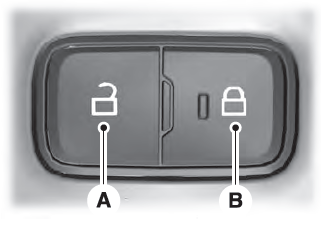Lincoln Aviator: Starting and Stopping the Engine / Keyless Starting
Note: The system may not function if the remote control is close to metal objects or electronic devices, for example keys or a cell phone.
Note: A valid remote control must be located inside your vehicle to switch the ignition on and start your vehicle.
Note: If the remote remains motionless for 40 or more seconds you need to move the remote for the passive entry feature to function. If the remote remains motionless for 8 or more hours you need to move the remote for the push button start feature to function.
Ignition Modes

The keyless starting system has three modes:
Off: Turns the ignition off.
- Without applying the brake pedal, press and release the button once when the ignition is in the on mode, or when your vehicle is running but is not moving.
On: All electrical circuits are operational and the warning lamps and indicators illuminate.
- Without applying the brake pedal, press and release the button once.
Start: Starts your vehicle. The engine may not start when your vehicle starts.
- Press the brake pedal, and then press the button for any length of time. An indicator light on the button illuminates when the ignition is on and when your vehicle starts.
 General Information
General Information
WARNING: Extended idling at high
engine speeds can produce very high
temperatures in the engine and exhaust
system, creating the risk of fire or other
damage...
 Starting a Gasoline Engine
Starting a Gasoline Engine
When you start the engine, the idle speed
increases. This helps to warm up the
engine. If the engine idle speed does not
slow down, have your vehicle checked as
soon as possible...
Other information:
Lincoln Aviator 2020-2025 Service Manual: Diagnosis and Testing - Intake Air Pressure and Temperature
Diagnostic Trouble Code (DTC) Chart Diagnostics in this manual assume a certain skill level and knowledge of Ford-specific diagnostic practices.REFER to: Diagnostic Methods (100-00 General Information, Description and Operation). Diagnostic Trouble Code Chart Module DTC Description Action PCM P007A:00 Charge Air Cooler Temperature Sensor Circuit (Bank 1): No Sub Type Information GO to Pinpoint Test DN PCM P007B:00 Charge Air Cooler Temperature Sensor Circuit Range/Performance (Bank 1): No Sub Type Information GO to Pinpoint Test DN PCM P007C:00 Charge Air Cooler Temperature Sensor Circuit Low (Bank 1) : No Sub Type Information GO to Pinpoint Test DN PCM P007D:00 Charge Air Cooler Temperature Sensor Circuit High (Bank 1) : No Sub Type Information GO to Pinpoint Test DN PCM P0096:00 Intake Air Temperature Sensor 2 Circuit Range/Performance (Bank 1): No Sub Type Information GO to Pinpoint Test DN PCM P0097:00 Intake Air Temperature Sensor 2 Circuit Low (Bank 1): No Sub Type Information GO to Pinpoint Test DN PCM P0098:00 Intake Air Temperature Sensor 2 Circuit High (Bank 1): No Sub Type Information GO to Pinpoint Test DN PCM P00CE:00 Intake Air Temperature Measurement System - Multiple Sensor Correlation (Bank 1): No Sub Type Information GO to Pinpoint Test DN PCM P0106:00 Manifold Absolute Pressure/Barometric Pressure Sensor Circuit Range/Performance: No Sub Type Information GO to Pinpoint Test DM PCM P0107:00 Manifold Absolute Pressure/Barometric Pressure Sensor Circuit Low : No Sub Type Information GO to Pinpoint Test DM PCM P0108:00 Manifold Absolute Pressure/Barometric Pressure Sensor Circuit High: No Sub Type Information GO to Pinpoint Test DM PCM P0109:00 Manifold Absolute Pressure/Barometric Pressure Sensor Circuit Intermittent: No Sub Type Information GO to Pinpoint Test DM PCM P012B:00 Turbocharger/Supercharger Inlet Pressure Sensor A Circuit Range/Performance: No Sub Type Information GO to Pinpoint Test DM PCM P012C:00 Turbocharger/Supercharger Inlet Pressure A Sensor Circuit Low: No Sub Type Information GO to Pinpoint Test DM PCM P012D:00 Turbocharger/Supercharger Inlet Pressure Sensor A Circuit High: No Sub Type Information GO to Pinpoint Test DM PCM P012E:00 Turbocharger/Supercharger Inlet Pressure Sensor A Circuit Intermittent/Erratic: No Sub Type Information GO to Pinpoint Test DM PCM P0235:00 Turbocharger/Supercharger Boost Sensor A Circuit: No Sub Type Information GO to Pinpoint Test DM PCM P0236:00 Turbocharger/Supercharger Boost Sensor A Circuit Range/Performance: No Sub Type Information GO to Pinpoint Test DM PCM P0237:00 Turbocharger/Supercharger Boost Sensor A Circuit Low: No Sub Type Information GO to Pinpoint Test DM PCM P0238:00 Turbocharger/Supercharger Boost Sensor A Circuit High: No Sub Type Information GO to Pinpoint Test DM PCM P025E:00 Turbocharger/Supercharger Boost Sensor A Intermittent/Erratic: No Sub Type Information GO to Pinpoint Test DM PCM P1104:00 Internal Control Module MAP Sensor Performance : No Sub Type Information GO to Pinpoint Test DM PCM P2227:00 Barometric Pressure Sensor A Circuit Range/Performance: No Sub Type Information GO to Pinpoint Test DO PCM P2228:00 Barometric Pressure Sensor A Circuit Low: No Sub Type Information GO to Pinpoint Test DO PCM P2229:00 Barometric Pressure Sensor A Circuit High: No Sub Type Information GO to Pinpoint Test DO PCM P2230:00 Barometric Pressure Sensor A Circuit Intermittent/Erratic: No Sub Type Information GO to Pinpoint Test DO PCM U060B:00 Lost Communication With Turbocharger/Supercharger Boost Sensor A: No Sub Type Information GO to Pinpoint Test DM PCM U066D:00 Lost Communication With Charge Air Cooler Temperature Sensor Bank 1: No Sub Type Information GO to Pinpoint Test DN Global Customer Symptom Code (GCSC) Chart Diagnostics in this manual assume a certain skill level and knowledge of Ford-specific diagnostic practices...
Lincoln Aviator 2020-2025 Service Manual: Removal and Installation - Passenger Side Footwell Air Discharge Temperature Sensor
Removal Fully lower the glove compartment. Disconnect the check strap. Push the stop tabs inward. Remove the passenger side register air discharge tempreature sensor. Disconnect the electrical connector...
Categories
- Manuals Home
- Lincoln Aviator Owners Manual
- Lincoln Aviator Service Manual
- Description and Operation - Jacking and Lifting
- Anti-Theft Alarm
- Child Safety Locks
- New on site
- Most important about car
Locking and Unlocking the Doors from Inside

Locking the Doors
Press the lock switch on the door interior trim panel. The doors can no longer be released using the exterior door handle switches and the luggage compartment locks.
